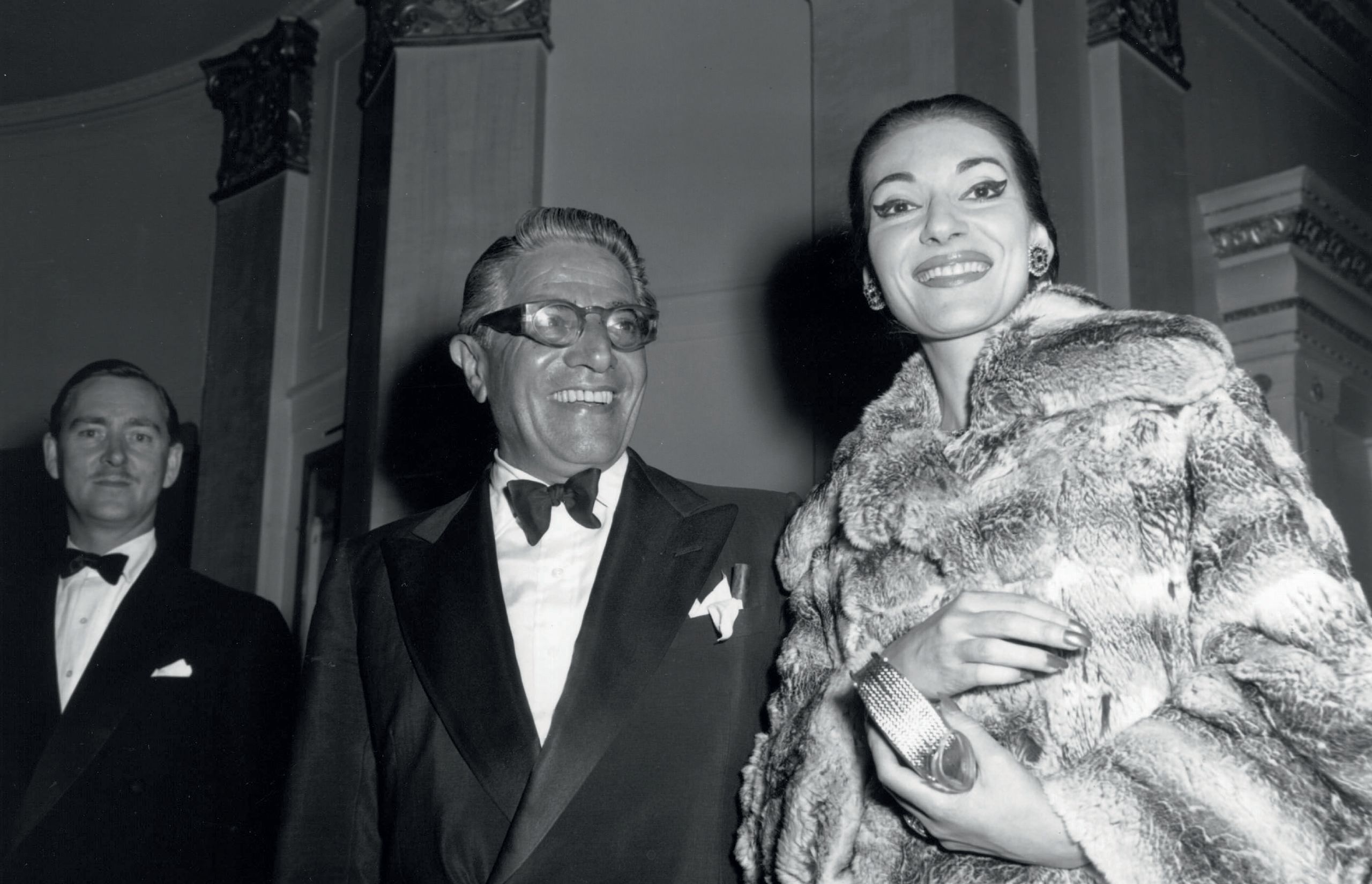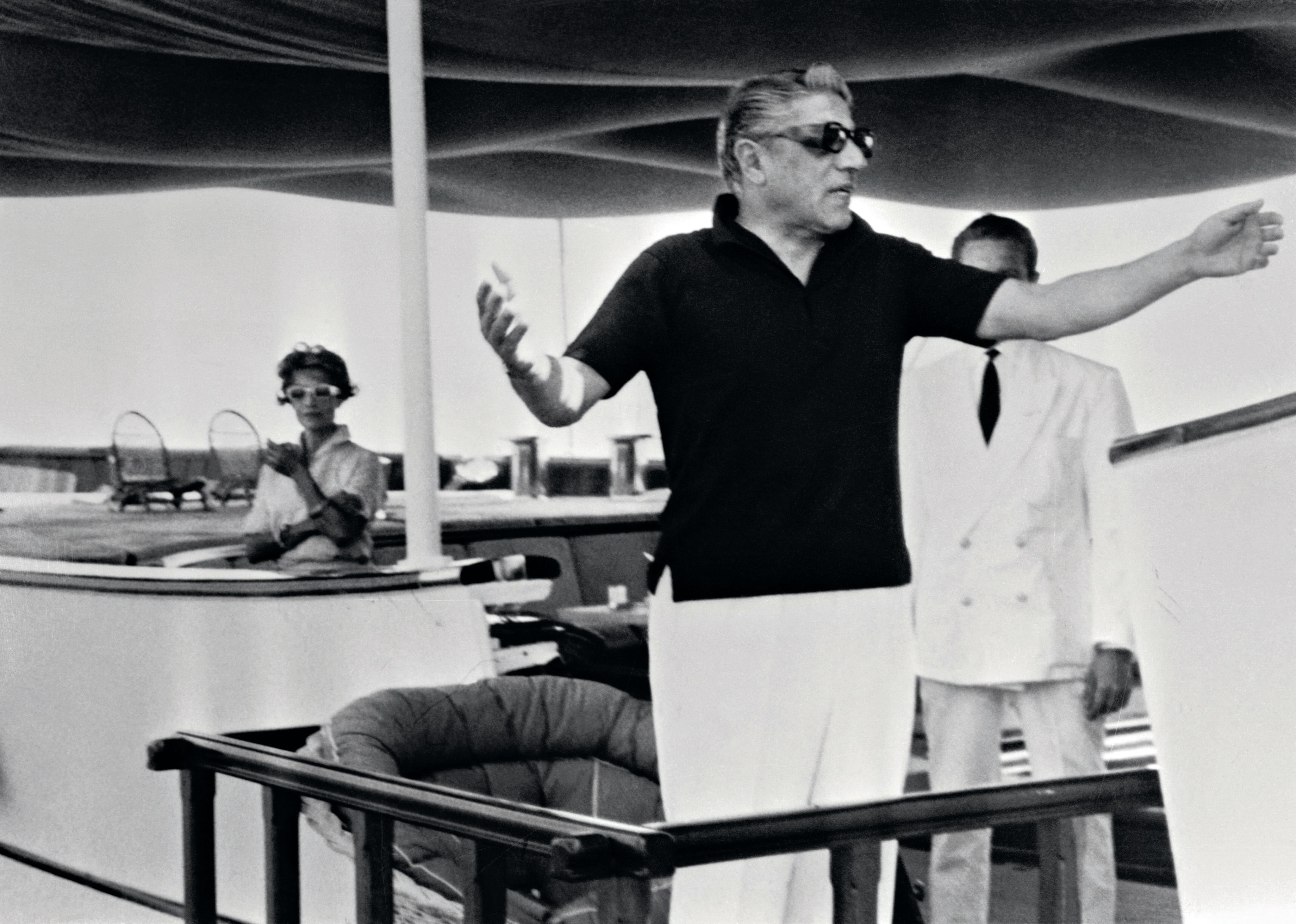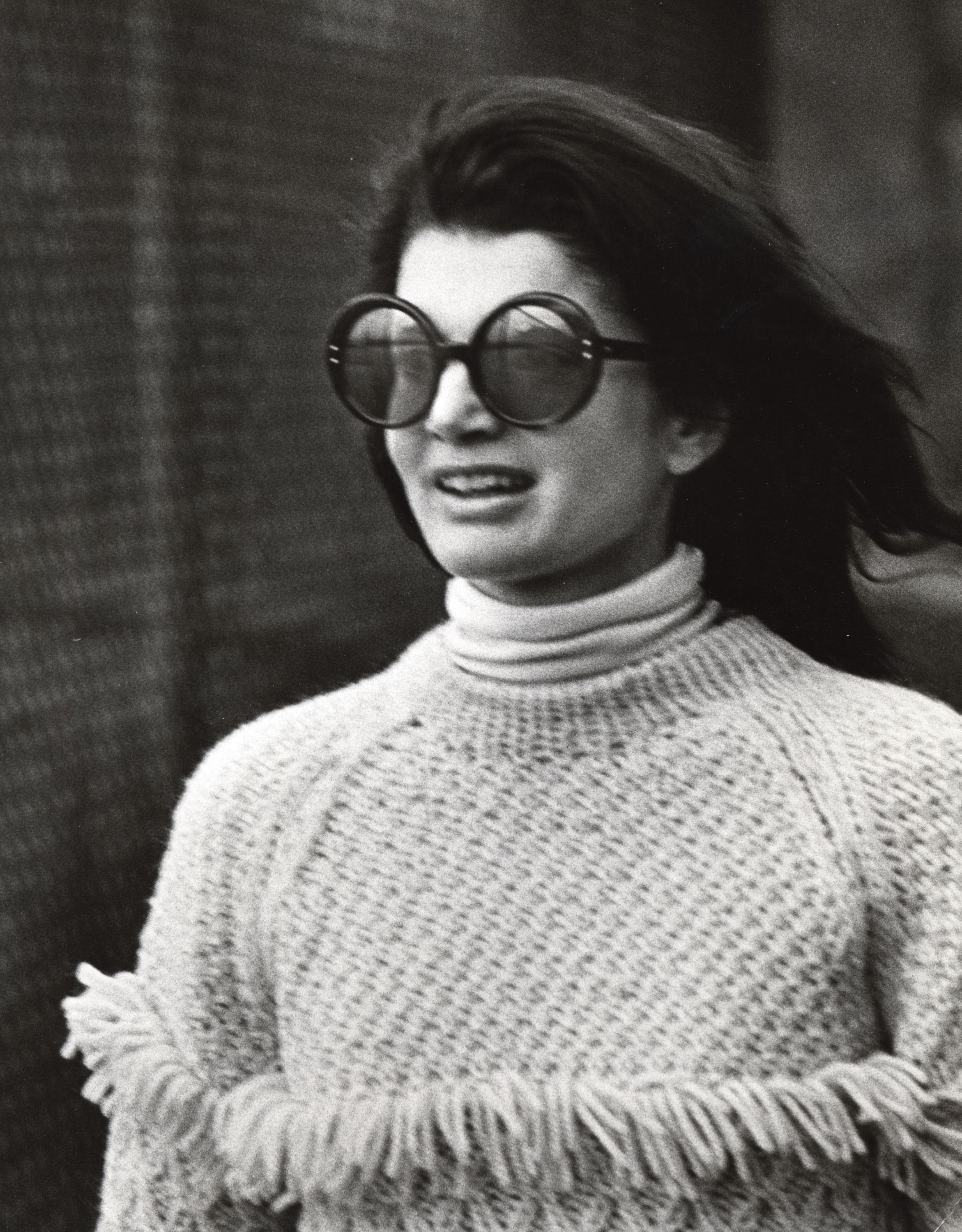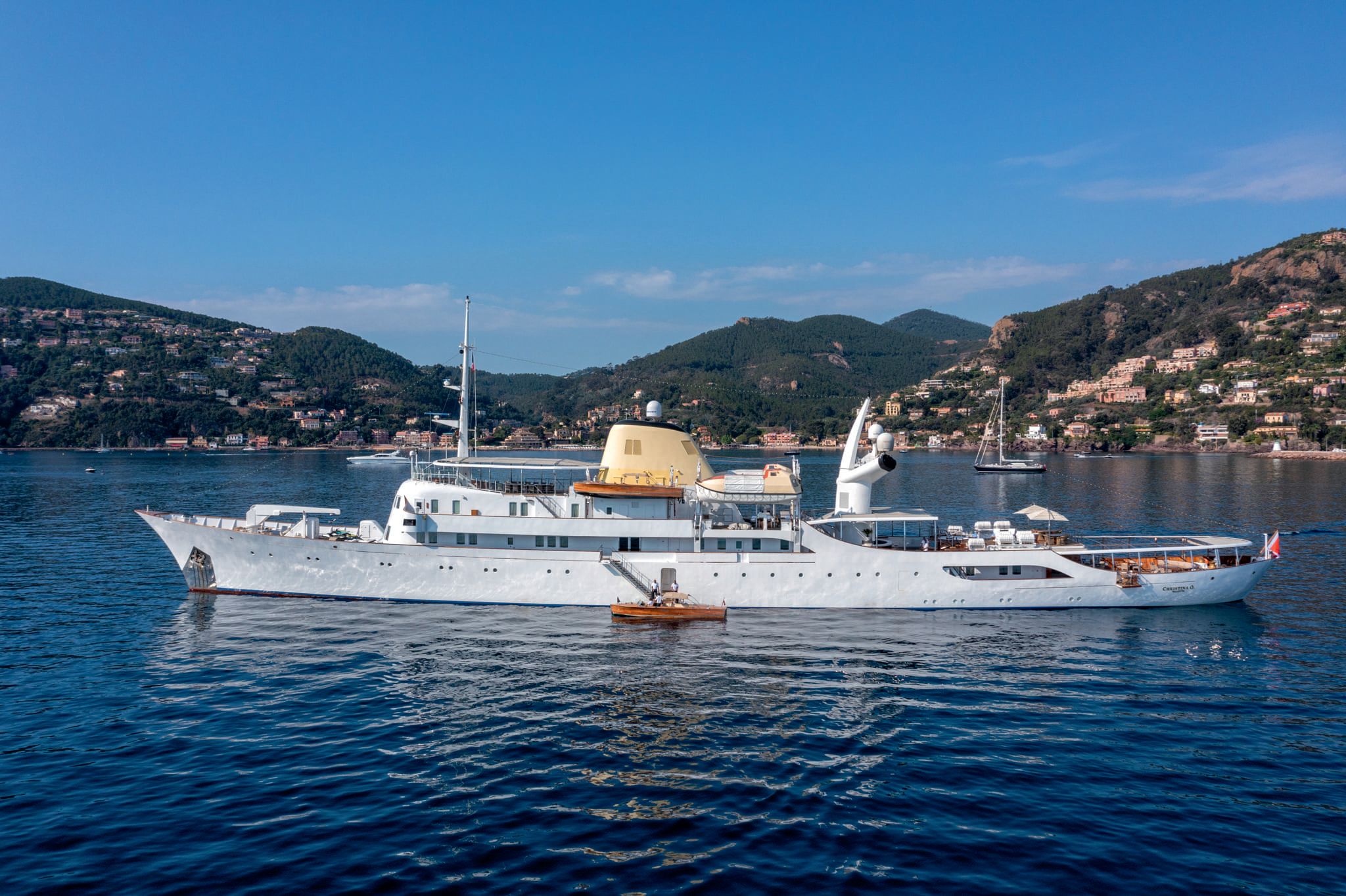
The untold story of Christina O

Twenty-five years ago, one of the world’s most famous yachts was restored to its former glory, rescued from a pile of rust. The rebuild smashed records, unearthed some tantalising glimpses into its owner, the late great Aristotle Onassis – and nearly broke naval architect Costas Carabelas. By Daniel Pembrey
STEF BRAVIN
“Big John” Papanicolaou, the Greek businessman who rescued Aristotle Onassis’s fabled yacht Christina (renamed Christina O), was a cigar-chomping, bear-like figure of a man with sharp-as-tacks intelligence matched only by his impatience. “I knew working for him on this boat would be a challenge,” recounts Costas Carabelas, the Greek naval architect who took on the design and management of the 18-month rebuild, which began 25 years ago in 1999. “I just didn’t appreciate how much.” Carabelas would suffer a heart attack because of the ordeal, but lives to tell the tale – here, for the first time. Papanicolaou, hereinafter Big John, died in 2010, aged just 60.
Christina was just as unique and rule-breaking as her first owner, who’d acquired the vessel half a century earlier. Shipping magnate Onassis had started out as a refugee in Buenos Aires and rose to become the richest man on the planet – and owner of the world’s most famous luxury yacht. The 99-metre was designed by the brilliant, controversial German Caesar Pinnau to offer otherworldly levels of opulence.



One anecdote serves to showcase the yacht’s significance. In 1959, Onassis invited aboard Sir Winston Churchill, opera singer Maria Callas (soon to become Onassis’s mistress), John F Kennedy and Kennedy’s wife, Jackie (later to become Onassis’s wife). Upon his death 16 years later, he left the boat to Jackie and his daughter, Christina, providing for $500,000 in annual upkeep of the vessel. The two women fell out and the boat was gifted to the Greek state, then abandoned, submerged, at a Greek naval base off the coast near Piraeus – which is where Big John found her.
Despite her demise, Christina’s legacy had lived on – among other ways, in the tans, sunglasses, espadrilles and similar accoutrements that set the trend for the superyacht lifestyle we now know. Alert to such shifts, Big John predicted a growth in the industry and the desire for bigger and bigger boats. “He’d say, ‘Forget about passenger, cargo or container ships; focus on yachts,’” recalls Carabelas. Rescuing Christina was an ambitious project – the “Rubik’s Cube” that the rebuild came to represent didn’t just result from Big John’s force of personality and unending interventions in the project.

Maria Callas with Sir Winston Churchill in 1959 ULLSTEIN BILD VIA GETTY IMAGES
Maria Callas with Sir Winston Churchill in 1959 ULLSTEIN BILD VIA GETTY IMAGES

ROGER VIOLLET VIA GETTY IMAGES
ROGER VIOLLET VIA GETTY IMAGES
Maria Callas and Winston Churchill on Christina, left, and with Aristotle Onassis in 1959
His vision was to scale up the accommodation from 24 to 34 guests, and the number of suites from 10 (including the owner’s) to 17 – all in an era (the 1990s) when boats rarely exceeded five cabins and 50 metres, and all in a narrow hull first built for speed. Providing for the extra facilities (seating, galleys, escape routes and other regulatory requirements), while keeping the yacht true to Onassis’s original vision, would, at times, seem Sisyphean.
“When John called asking me
to work on her, it was both a
dream and a nightmare scenario”
Informed sources put the cost of the rebuild above $40 million (£31 million) – significantly more than the inflation-adjusted amount ($25 million) Onassis spent in 1953 ($4 million), converting the original Canadian frigate that he’d acquired after the Second World War for around just $30,000. Ingrained in the Greek ship-owning psyche was this ethos of repurposing secondhand vessels, and it was an ethos that Big John made good use of, as a hedge against the daunting financial costs: go after famous, even infamous yachts, whose renown or notoriety could take care of the marketing. It was a bold bet, but he was used to placing those.

STEF BRAVIN The vessel has had several owners, the last one renaming her Christina O
STEF BRAVIN The vessel has had several owners, the last one renaming her Christina O
Big John was an ex-ship owner himself and a significant real estate player with contacts in Montenegrin casino operations. He acquired the 117-metre Galeb, previously owned by Yugoslovian President Tito from the Montenegrin government. Another adventure took him and Carabelas to Nice, to buy Basrah Breeze, Saddam Hussein’s old boat. Yet Christina was the biggest prize. “What you have to understand is that Onassis had showed Greek people what was possible,” says Carabelas. “He proved to us that we could be people of consequence on the world stage. His one famous rule was that there were no rules, and without him and his audacity, the Greek shipping industry might be a third of what it is today.” Christina, named after the celebrated man’s daughter, projected all this and more. Perhaps Big John hoped that some of Onassis’s Midas touch might rub off on him.
Whereas Carabelas had revered Onassis and his famous yacht from afar, Big John knew both. He in fact came from Greek aristocracy; his parents had worked for the Greek royal family and his father was friendly with Onassis. As a young boy, he had been aboard. He knew Ari’s Bar and the barstools fashioned from whale scrotum. He knew the lounges in which Callas had sung, the library in which Churchill had read and snoozed, the mosaic swimming pool that shapeshifted into a dance floor and the movements of the other heads of state and celebrities who’d been there (Garbo, Monroe, Wayne, Sinatra, Burton, Taylor and on).
He knew Christina’s secrets, shape and feel; the disposition of her many tenders (including a glass-bottomed boat and a hydrofoil, not to forget the seaplane), the Aegean views from the aft deck at sunset and the gleaming, mythic interior details. For Big John, this project was business and personal.
Following Onassis’s death and the boat’s abandonment, scavengers targeted its ornaments, for example the gold used for maps embossing the cabin doors, with each map depicting a Greek island after which the cabin was named. “Thankfully, the looters didn’t appreciate the historic value of some of the other interiors such as Ari’s Bar and overlooked those,” says Carabelas.
The yacht's sorry condition helped deter other serious suitors, facilitating Big John’s acquisition of her in 1998 as part of an investor consortium. “When John called asking me to work on her, it was both a dream and nightmare scenario,” Carabelas says. Just how problematic the project would become was soon revealed. Cleaning the hull with high-pressure hoses opened up two enormous cavities in the steel. Ultrasonic testing of the plating suggested that 65 per cent of the hull needed replacing, rather than the 20 per cent originally predicted. This meant that instead of dry docking the boat for 60 days as anticipated, she would spend 345 days there. Ultimately, 630 tonnes of new steel and 95 tonnes of aluminium would be needed.
No Greek shipyard was available for 12 consecutive months. Carabelas managed to squeeze the wreck into the Viktor Lenac shipyard in Rijeka, Croatia. “We ended up keeping just two metres of the hull at the fore and aft,” Carabelas says. “ Even there, the sunk rivets of the wartime frigate needed special protection and treatment, meaning that many times the amount of work and replacement cost were spent saving those fragments [versus starting anew with them].” All pipework, cables, electrical systems and plumbing needed replacing. An estimated 90 kilometres of new wiring and 14 tonnes of pipework went in.
It soon evoked the ship of Theseus, and the paradox of identity: if all the parts of a vessel are replaced, one by one, when is it new again and not original? Was the historic Christina destined to slip away, after all, in this fashion? Big John thought he had an answer both to this paradox and the gathering sense of crisis. Carabelas recalls being sat down by Big John, who laid out old photos of the interiors, dating to the golden years of the boat, stipulating: “I want the interiors reinstated to be the same. Exactly the same,” he emphasised, thumping a black-and-white photo with his stout forefinger.

STEF BRAVIN
STEF BRAVIN

STEF BRAVIN
STEF BRAVIN

EDWARD QUINN
EDWARD QUINN

STEF BRAVIN
STEF BRAVIN
(Top row) The aft deck as Christina O in 1999; the compass deck as it is now. (Bottom row) the aft deck with the pool when it was Christina; Onassis’s first wife, Tina, on board Christina in 1958; the aft deck with pool in 1999
Apostolos Molindris, the renowned Greek architect, was appointed to devise a general arrangement or master plan that could reconcile the dizzying array of requirements, both aesthetic and functional. Big John, Carabelas and Molindris became the three -pronged trident pushing the project on. But Molindris was surprised by what he found. “In reality, John didn’t have that many photos, so we started doing picture research on the Onassis years using back copies of Life and the like,” Molindris explains. “What we were finding didn’t entirely marry up with the legend of the yacht.”
Everyone knew the lore of Christina, or thought they did. At the centre of it was the mythic extravagance of the Onassis years and the intensely proprietorial approach of the owner himself. “You could smash a $20,000 speedboat to pieces and not a word would be said,” a crew member recalled, “but spit on the Christina’s deck, and you were out of a job.”
Top row: a saloon on board Christina O; the main stairwell revived, showing Christina’s Omega-and-laurelwreath logo; Onassis’s first wife, Tina, on board Christina in 1958; Onassis on board in 1961. Botton row: Onassis on board Christina in 1961, leaning on the famed lapis lazuli fireplace; the Sir Winston Churchill library on board; the drawing room on Christina; Christina O’s Onassis suite
Yet the more Molindris scrutinised the old interiors, the less basis he found for this lore. “Some of the artwork – the El Grecos, for example – were known to be fakes, which makes sense; it’s risky to hang priceless artworks on the high seas,” Molindris says. (Onassis had reportedly said, “If people want to believe they are authentic, why spoil their pleasure?”) “However, the famed lapis lazuli fireplace, which the looters left in place, had only a veneer of the precious stone. The balustrade of the spiral staircase in the central atrium was brass and marble but not remarkable. The stateroom’s gold faucets, taken, revealed fitments that were gold-painted metal.”
Providing for the extra facilities while keeping the yacht true to Onassis’s vision would, at times, seem Sisyphean
Even Ari’s Bar, left largely intact, raised as many questions as it answered. The legend was that this space had received as much love and care as anywhere, perhaps because of the money Onassis made from whaling (while reportedly flouting international whaling laws). The legend was that celebrities steadied themselves with handrails formed from the purest whale-tooth ivory, engraved with scenes from the Iliad and the Odyssey; their well-shod feet found footrests made from the teeth of a sperm whale, while their gazes lingered on wall-mounted timber purportedly from a Spanish galleon. Even allowing for the badly distressed state of the bar stools, it looked more kitschy than legendary when empty and not animated by those famous people, notably Onassis ,” says Molindris . “The glass of the bar counter was so thin that if you leaned on it too heavily, it might crack. It all showed just what a good salesman Onassis had been, and revealed how central his personality was to the way this boat worked.” Only, now, Big John needed the legend to be made real.
It soon evoked the ship of Theseus: if all the parts of a vessel are replaced, when is it new again and not original?

Meanwhile, for Carabelas, the conflicting goals of the rebuild were colliding at the very heart of the boat, where a new dining room was needed if the vessel were to accommodate three dozen guests (the previous dining room could only seat 12). “For John, omitting this room was a deal breaker for the entire project,” underscores Carabelas. Its inclusion needed to avoid disturbing any of the storied spaces, such as the bar. Helpfully, the removal of the original 1943 steam engines and boilers freed up space, but back in went two low-speed tubeless MAN diesel engines (the fluid systems were encased in the engine blocks), chosen to maximise the life of the power trains. They delivered a top speed of 19 knots, and massive torque at 800RPM – perhaps the same as an MTU or a Caterpillar engine running at 2,300RPM. The lower revs did guarantee longer maintenance intervals, yet the engines were tall.
“It was the turning point,” says Carabelas, with relief plain in his features a quarter of a century on
The gap in height between the engines and the main deck, earmarked for the new dining room, was the height of Big John – 200 centimetres. Carabelas recalls Big John towering over him, telling him that this could not stand. A solution was to pop the ceiling up through the main decking. “Impossible,” ruled Big John. It was as if he were channelling Onassis from the Howaldtswerke-Deutsche Werft in Kiel where the first conversion took place. There, Onassis had reportedly required the wheelhouse, resembling a whale’s head, to be redone – three times. The exterior shape of the boat was sacrosanct; the dining room ceiling could not be raised. “The boat’s profile cannot be changed,” bellowed Big John.

STEF BRAVIN
STEF BRAVIN

STEF BRAVIN
STEF BRAVIN

JAMES MCNAUGHT
JAMES MCNAUGHT
Top and bottom left: Christina O’s Jacuzzi deck; bottom right: Hacker-Craft tenders
It did indeed seem impossible; fundamentally irreconcilable. In the late 1990s, 3D design software was not widespread. Certainly, Carabelas did not have it . He had his imagination, the time aboard the weekly flights shuttling him between the design work being done in Athens and the work undertaken in Rijeka (a trip he made 70 times), and the sense of the clock relentlessly running down. The feeling of fast, calm forward motion while airborne seemed to help his thinking, however.
The Eureka moment came from an unexpected quarter. In the master stateroom, Onassis had insisted on being able to step down from a sunken bath carved from Siena marble (a replica of one found at a palace in ancient Crete). The floor had in fact needed to be raised in order to provide him with the requisite descent, and the bath had since been removed, but the idea remained: could a similar step-down work for the dining room?
Yes. The floor plan of a narrowed dining space, in which the table was arranged longitudinally, could indeed be dropped down by several precious centimetres, in between the two big MAN engines beneath. “It was the turning point,” says Carabelas, with relief plain in his features a quarter of a century on. Molindris worked hard to upgrade the adjacent staircase-atrium in a way that felt authentic. Steps acquired sumptuous dark carpet between exposed marble edges; the mosaic installed at the very bottom, revealing Christina’s Omega-and laurel-wreath logo, lent a fitting focal point.
Connecting the various levels of the staircase to other key spaces and a passenger lift created a greater sense of openness and movement at the centre of the boat. Nearby, Ari’s Bar was painstakingly reassembled with subtle improvements in the wood, rope and other fixtures and fittings, not to forget thickened glass for the bar top, all of which lets guests experience the legend, unmarred.
ONASSIS VS NIARCHO
Shipping rivals - in love, life and yachts
ONASSIS VS NIARCHO
Shipping rivals - in love, life and yachts

SLIM AARONS-HULTON ARCHIVE-GETTY IMAGES
SLIM AARONS-HULTON ARCHIVE-GETTY IMAGES

KEYSTONE-HULTON ARCHIVE-GETTY IMAGES
KEYSTONE-HULTON ARCHIVE-GETTY IMAGES

BETTMANN - GETTY IMAGES
BETTMANN - GETTY IMAGES

BETTMANN - GETTY IMAGES
BETTMANN - GETTY IMAGES

JACK GAROFALO- PARIS MATCH VIA GETTY IMAGES
JACK GAROFALO- PARIS MATCH VIA GETTY IMAGES

JAMES ANDANSON-SYGMA VIA GETTY IMAGES
JAMES ANDANSON-SYGMA VIA GETTY IMAGES
Top row: Niarchos’s sailing yacht Creole in 1967; Stavros Niarchos; the 50-knot-plus motor yacht Mercury built for Niarchos. Bottom row: Niarchos (on left) with his representative at a shipyard in Germany in 1954; Niarchos on board his 65m sailing yacht Creole; Niarchos’s 116m Atlantis in 1977, a longer version of Christina, penned by the same designer
One of the few personalities who came close to Onassis as a “man of mark” (to use Churchill’s description of Onassis) was Stavros Niarchos (1909-1996), who was three years younger than his fellow Greek shipping billionaire. Both men married into the illustrious Livanos shipping family, becoming brothers-in-law, then rivals.
Competing in shipping, real estate (Greek islands, French Riviera villas) and the social sphere, Niarchos appeared to live the maxim that imitation is the sincerest form of flattery. Each time Onassis ordered a giant new tanker for his fleet, Niarchos would order an even bigger ship.
Niarchos would end up marrying Onassis’ first wife, Tina. With pleasure craft, Niarchos initially opted for his three-masted wooden 65-metre sailing yacht Creole, but ended up commissioning essentially a copy of Christina, using the same designer, Caesar Pinnau. Atlantis (1973) had a strikingly similar profile and general arrangement, but stretched from 99 to 116 metres. She was built 20 years after the creation of Christina, with the same light oak interiors but with a couple more cabins and a larger owner’s apartment.
Another difference lay in the art aboard: it was all real. Niarchos was a very serious collector. Around the time Onassis died in 1975, Niarchos sold Atlantis, making many times his money – something unheard of in yachting then. (She became a possession of the Saudi royal family; today, she is Navtilvs.)
In the late 1970s, Niarchos commissioned an almost identical boat to Atlantis. Pinnau returned to design Atlantis II (1981). Like the first Atlantis, she was built at Hellenic, Niarchos’ own yard near Athens.
By now, Christina was property of the Greek state, but, rebuilt as Christina O, she would claim the prize for the most rooms of all – if not most overall room. Atlantis II remains in the Niarchos family. Her home is Monaco, and she and Christina O can sometimes be found circling one another, inadvertently, in the Mediterranean and Aegean Seas, as if the driving forces of Stavros Niarchos and Aristotle Onassis live on (many would argue they do).
Both yachts can be considered ultra-rare, “200-year” vessels. Indeed, it is hard to imagine them ever being decommissioned. While Niarchos and Onassis came to be regarded as enemies, they had the kind of mutual admiration that could only arise from a deep understanding of what one another achieved in business and beyond.
They invited each other aboard their yachts, and one story, perhaps apocryphal, sums it all up: the two men allegedly having lunch in New York City, after which they strolled past a Bentley showroom and bought a Corniche model each. Niarchos gestured to pick up the bill. “No, no, Stavros,” interceded Onassis, “let me get these; you paid for lunch.”
Other elements might feel more familiar to those undertaking rebuilds today: among them, the relocation of the exhaust from the famous yellow funnel to the aft mast (the funnel becoming home to the air con units) and the overhaul of the tender fleet to include two wooden Hacker-Craft and enclosed lifeboats as well as life rafts. Yet the swimming pool/dance floor, the restoration of which took a full year itself, was unique. “Why did Onassis have this?” Molindris asks. “The yacht has ample deck space. There was room for both a pool and a separate dance floor. The answer seems to be that he liked the novelty of something that hadn’t been seen before.”

STEF BRAVINThe Onassis suite
STEF BRAVINThe Onassis suite
That novelty needed to be renewed. The pool/dance floor’s mosaic recreates a scene of a gymnast vaulting a Minoan bull from the Knossos Palace in Crete dated to circa 1,550 BCE – not the Minotaur, as is often assumed. Original mosaic tiles were retained. The pure copper pool surround is original as well – so too the intricate mechanism controlling the up - and-down movement of the floor, which is also regarded as a work of art, and housed in the steering room. The mechanism shares space with the stern thruster, which took over from the single rudder originally determined by the hull’s shape.

STEF BRAVIN The restored yacht, renamed Christina O
STEF BRAVIN The restored yacht, renamed Christina O
The specification of the interior furnishings made good on the expectations of Onassis’s earlier guests: in the dining room, there is the porcelain service by Bernardaud of Limoges, Waterford crystal by Rochas, and silverware by Ercuis and St Hilaire of Paris. Fabrics are from Mulberry; furniture is by Giorgetti. Despite deploying full-scale mockups, Molindris alone notched up 200 plan revisions courtesy of Big John. Still, “The project remains truly memorable after all these years,” says Molindris from the studio of his successful architecture practice on the Athens Riviera. Carabelas’ heart attack occurred right after the rebuild ended. He attributed it to “the stress that accumulated day by day” – and also a related back operation. “I don’t think a person can do such a job twice in one life,” he concludes. He remains a highly sought-after naval architect, and indeed continues to work on Christina O’s evolving needs.

CARLO BAVAGNOLI - MONDARODI VIA GETTY IMAGES
CARLO BAVAGNOLI - MONDARODI VIA GETTY IMAGES

STEF BRAVIN
STEF BRAVIN

STEF BRAVIN
STEF BRAVIN

STEF BRAVIN
STEF BRAVIN
Top row: Ari’s Bar in 1961 and after restoration. Bottom row: The refit included an overhaul of the tender fleet, which added two wooden Hacker-Craft that perfectly complement the classic mothership
Big John’s force of personality tested relations with other members of the ownership consortium. When he died (within a decade of the rebuild completing), his share passed to them. For all of the difficulties he caused, rare is it for a yacht to be described as one that can outlast any person alive, and he must take credit for the fact that Christina O is described in precisely this way. Ultimately, though, the legacy belongs to Onassis. Lloyd’s List named him as one of the three most influential men of the 20th century, alongside Malcom McLean, inventor of the modern shipping container, and Ted Arison, founder of Carnival Cruise Lines. From well beyond the grave, his presence – and the fascination with him felt by so many – lives on via this yacht.
Richard Burton said about Christina, “I don’t think there is a man or woman on earth who would not be seduced by the pure narcissism shamelessly flaunted on this boat.” Onassis allegedly responded, “I have found that to be so.” Over the 25 years that have elapsed since the rebuild began, one could argue that it is fairer to speak of pride than narcissism, but her enduring ability to seduce is beyond doubt, and the odds are good that she will continue to do so well into the 22nd century.
Christina O is available for sale and charter with Morley Yachts.
First published in the March 2024 issue of BOAT International. Get this magazine sent straight to your door, or subscribe and never miss an issue.

